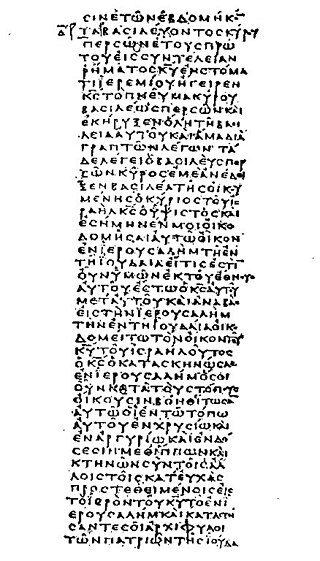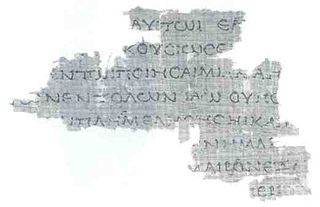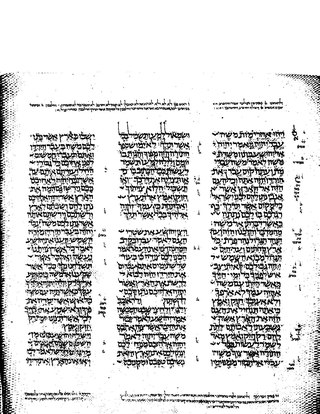The deuterocanonical books are books and passages considered by the Catholic Church, the Eastern Orthodox Church, the Oriental Orthodox Churches, and/or the Assyrian Church of the East to be canonical books of the Old Testament, but which Jews and Protestant denominations regard as apocrypha. They date from 300 BC to 100 AD, mostly from 200 BC to 70 AD, before the definite separation of the Christian church from Judaism. While the New Testament never directly quotes from or names these books, the apostles most frequently used and quoted the Septuagint, which includes them. Some say there is a correspondence of thought, and others see texts from these books being paraphrased, referred, or alluded to many times in the New Testament, depending in large measure on what is counted as a reference.

The Septuagint, sometimes referred to as the Greek Old Testament or The Translation of the Seventy, and often abbreviated as LXX, is the earliest extant Greek translation of the Hebrew Bible from the original Hebrew. The full Greek title derives from the story recorded in the Letter of Aristeas to Philocrates that "the laws of the Jews" were translated into the Greek language at the request of Ptolemy II Philadelphus by seventy-two Hebrew translators—six from each of the Twelve Tribes of Israel.

The Torah is the compilation of the first five books of the Hebrew Bible, namely the books of Genesis, Exodus, Leviticus, Numbers and Deuteronomy. It is known as the Pentateuch or the Five Books of Moses by Christians. It is also known as the Written Torah in Jewish tradition. If meant for liturgic purposes, it takes the form of a Torah scroll. If in bound book form, it is called Chumash, and is usually printed with the rabbinic commentaries.

The Samaritan Torah, commonly called the Samaritan Pentateuch, is a text of the Torah written in the Samaritan script and used as sacred scripture by the Samaritans. It dates back to one of the ancient versions of the Hebrew Bible that existed during the Second Temple period, and constitutes the entire biblical canon in Samaritanism.
In Judaism, the korban, also spelled qorban or corban, is any of a variety of sacrificial offerings described and commanded in the Torah. The plural form is korbanot, korbanoth, or korbanos.
Martin Noth was a German scholar of the Hebrew Bible who specialized in the pre-Exilic history of the Hebrews and promoted the hypothesis that the Israelite tribes in the immediate period after the settlement in Canaan were organised as a group of twelve tribes arranged around a central sanctuary on the lines of the later Greek and Italian amphictyonies. With Gerhard von Rad he pioneered the traditional-historical approach to biblical studies, emphasising the role of oral traditions in the formation of the biblical texts.
In contrast to the variety of absolute or personal names of God in the Old Testament, the New Testament uses only two, according to the International Standard Bible Encyclopaedia. From the 20th century onwards, "a number of scholars find various evidence for the name [YHWH or related form] in the New Testament.
Alfred Rahlfs was a German Biblical scholar. He was a member of the history of religions school. He is known for his edition of the Septuagint published in 1935.

The Tetragrammaton, or the Tetragram, is the four-letter Hebrew theonym יהוה, the name of God in the Hebrew Bible. The four letters, written and read from right to left, are yodh, he, waw, and he. The name may be derived from a verb that means "to be", "to exist", "to cause to become", or "to come to pass". While there is no consensus about the structure and etymology of the name, the form Yahweh is now accepted almost universally, though the vocalization Jehovah continues to have wide usage.
The New English Translation of the Septuagint and the Other Greek Translations Traditionally Included under That Title (NETS) is a modern translation of the Septuagint (LXX), that is the scriptures used by Greek-speaking Christians and Jews of antiquity. The translation was sponsored by the International Organization for Septuagint and Cognate Studies (IOSCS). The Psalms were published in 2000 and the complete Septuagint in 2007.

The Rylands Papyri are a collection of thousands of papyrus fragments and documents from North Africa and Greece housed at the John Rylands University Library, Manchester, UK. The collection includes the Rylands Library Papyrus P52, also known as the "St John's fragment", a fragment from a papyrus codex, generally accepted as the earliest extant record of a Canonical gospel.

Papyrus Rylands 458 is a manuscript of the Pentateuch in the Greek Septuagint version of the Hebrew Bible. It is a roll made from papyrus, which has survived in a very fragmentary condition. It is designated by the number 957 on the list of Septuagint manuscripts according to the numbering system devised by biblical scholar Alfred Rahlfs. Using the study of comparative writing styles (palaeography), the manuscript has been dated to the middle of the 2nd century BCE.

The Papyrus Fouad 266 are fragments, part of a papyrus manuscript in scroll form containing the Greek translation, known as the Septuagint, of the Pentateuch. They have been assigned palaeographically to the 1st century BCE. There is discussion about whether the text is original or a later recension of the Septuagint.

1 Kings 8 is the eighth chapter of the Books of Kings in the Hebrew Bible or the First Book of Kings in the Old Testament of the Christian Bible. The book is a compilation of various annals recording the acts of the kings of Israel and Judah by a Deuteronomic compiler in the seventh century BCE, with a supplement added in the sixth century BCE. This chapter belongs to the section focusing on the reign of Solomon over the unified kingdom of Judah and Israel. The focus of this chapter is the dedication of Solomon's Temple in Jerusalem.

The manuscript 4Q120 is a Septuagint manuscript (LXX) of the biblical Book of Leviticus written on papyrus, found at Qumran. The Rahlfs-No. is 802. Palaoegraphycally it dates from the first century BCE. Currently the manuscript is housed in the Rockefeller Museum in Jerusalem.

Ezekiel 45 is the forty-fifth chapter of the Book of Ezekiel in the Hebrew Bible or the Old Testament of the Christian Bible. This book contains the prophecies attributed to the prophet/priest Ezekiel, and is one of the Books of the Prophets. The final section of Ezekiel, chapters 40-48, give the ideal picture of a new temple. The Jerusalem Bible refers to this section as "the Torah of Ezekiel". In particular, chapters 44–46 record various laws governing the rites and personnel of the sanctuary, as a supplement to Ezekiel's vision.
Kristin Mimi Lieve Leen De Troyer is an Old Testament scholar, theologian, writer and an (honorary) professor who has taught at different universities such as the University of Salzburg, the University of St Andrews, and Claremont School of Theology. She is the author of many scholarly books and articles, an editor of several academic series, and a professor and researcher of the Hebrew Bible, the Septuagint, Judaism and the Dead Sea Scrolls. Since the beginning of 2021, she serves as the Secretary of the European Academy of Sciences and Arts.
AlbertPietersma is Dutch professor emeritus of Septuagint and Hellenistic Greek in the Department of Near and Middle East Civilizations at the University of Toronto‘s Faculty of Arts and Science.

Joshua 5 is the fifth chapter of the Book of Joshua in the Hebrew Bible or in the Old Testament of the Christian Bible. According to Jewish tradition, the book was attributed to the Joshua, with additions by the high priests Eleazar and Phinehas, but modern scholars view it as part of the Deuteronomistic History, which spans the books of Deuteronomy to 2 Kings, attributed to nationalistic and devotedly Yahwistic writers during the time of the reformer Judean king Josiah in 7th century BCE. This chapter focuses on the circumcision and Passover of the Israelites after crossing the Jordan River under the leadership of Joshua, a part of a section comprising Joshua 1:1–5:12 about the entry to the land of Canaan, and the meeting of Joshua with the Commander of the Lord's army near










